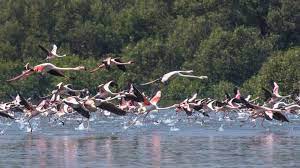CURRENT AFFAIRS
Get the most updated and recent current affair content on Padhaikaro.com
Four New Ramsar Sites
- Vaid's ICS, Lucknow
- 16, Dec 2021

Why in news?
According to recent estimates by Wetlands International South Asia, nearly 30% of the natural wetlands in India have been lost in the last three decades. Majorly, the loss of Wetlands is more prominent in Urban areas.
- Wetlands International South Asia was established in 1996, with an office in New Delhi, as a part of Wetlands International network to promote conservation and sustainable development of wetlands in the South Asia region.
About Wetlands:
- Wetlands are ecosystems saturated with water, either seasonally or permanently.
- They include mangroves, marshes, rivers, lakes, deltas, floodplains and flooded forests, rice-fields, coral reefs, marine areas no deeper than 6 metres at low tide, as well as human-made wetlands such as waste-water treatment ponds and reservoirs.
- Though they cover only around 6% of the Earth’s land surface, 40% of all plant and animal species live or breed in wetlands.
New Ramsar Sites:
- Recently, the Ramsar Convention has designated four new wetlands in India, as wetlands of global importance. It is an international treaty for the conservation and wise use of wetlands.
- Bhindawas Wildlife Sanctuary, the largest wetland in Haryana is a human-made freshwater wetland.
- Sultanpur National Park from Haryana supports more than 220 species of resident, winter migratory and local migratory waterbirds at critical stages of their life cycles.
- Thol Lake Wildlife Sanctuary in Gujarat lies on the Central Asian Flyway and more than 320 bird species can be found here.
- Wadhwana Wetland from Gujarat is internationally important for its birdlife as it provides wintering ground to migratory water birds, including over 80 species that migrate on the Central Asian Flyway.
- These wetlands are home to endangered bird species like Egyptian Vulture, Saker Falcon, Sociable Lapwing, and the near threatened Dalmatian Pelican.
- With this, the number of Ramsar sites in India are 46.
Facts for Prelims:
White giraffe:
The only known white giraffe that has been in the news recently is found in Kenya.
The giraffe is equipped with a GPS tracking device to help protect it from predators.
- Leucism, a genetic trait that causes white color in animals.
- The only male giraffe is in a dangerous position at risk of poaching.
- The GPS tracking device, which is attached to one of the giraffe’s horns, will alert wildlife rangers about its location.
Equivalent levy:
(Equalization Levy)
- This tax is based on the principle that a seller in the digital world can engage in business transactions without any physical presence and that governments have a legitimate right to impose such transactions.
- Equivalent levy was introduced by the Government of India in the year 2016.
It was imposed on the revenue generated as a result of business-to-business digital advertisements and related services from resident service providers.